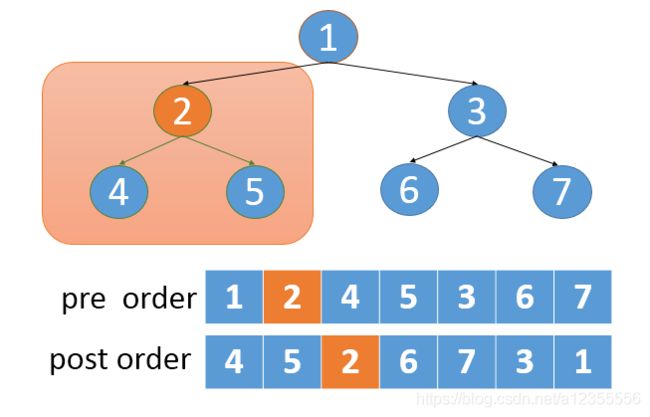Leetcode 889. 根据前序和后序遍历构造二叉树-105. 从前序与中序遍历序列构造二叉树-106. 从中序与后序遍历序列构造二叉树
文章目录
-
- 题目
- 解题思路
- 根据中序、后序构造树
- 根据中序、前序构造树
- 前序,后序构造树
- 中序存在与否对树的构建有什么影响
题目
根据一棵树的前序遍历与中序遍历构造二叉树。
注意:
你可以假设树中没有重复的元素。
例如,给出
前序遍历 preorder = [3,9,20,15,7]
中序遍历 inorder = [9,3,15,20,7]
返回如下的二叉树:
3
/ \
9 20
/ \
15 7
后序遍历 postorder = [9,15,7,20,3]
解题思路
中序可以和前序、后序、层序的任意一个搭配来构建唯一的二叉树。
若没有中序,其他的序列搭配都无法构建唯一的二叉树,因为先序、后序、层序都用于提供根结点,只有中序才能区分左右子树。
根据中序、后序构造树
class Solution {
private int[] post; //后序序列
private Map<Integer, Integer> map; //哈希表记录结点值在中序里的下标
public TreeNode buildTree(int[] inorder, int[] postorder) {
post = postorder;
map = new HashMap<>();
for(int i = 0; i < inorder.length; i++)
map.put(inorder[i], i);
return helper(0, inorder.length - 1, post.length - 1);
}
/**
* 根据中序始末下标构建树
* @param begin 中序的起始下标
* @param end 中序的结束下标
* @param postidx 根结点在后序里的下标
* @return 返回树的根结点
*/
private TreeNode helper(int begin, int end, int postidx) {
if(begin > end) return null; //没有结点,返回空树
int rootidx = map.get(post[postidx]); //根结点在中序里的下标,用于区分左右子树
TreeNode root = new TreeNode(post[postidx]);
int rightcnt = end - rootidx; //右子树结点数
root.left = helper(begin, rootidx - 1, postidx - rightcnt - 1); //根据子树的中序构建子树
root.right = helper(rootidx + 1, end, postidx - 1);
return root;
}
}
根据中序、前序构造树
class Solution {
private int[] pre; //前序
private Map<Integer, Integer> map; //哈希表用于记录结点值在中序里的下标
public TreeNode buildTree(int[] preorder, int[] inorder) {
pre = preorder;
map = new HashMap<>();
for(int i = 0; i < inorder.length; i++)
map.put(inorder[i], i);
return helper(0, inorder.length - 1, 0);
}
/**
* 根据中序始末下标构建树
* @param begin 中序起始下标
* @param end 中序结束下标
* @param preidx 根结点在前序里的下标
* @return 返回树的根结点
*/
private TreeNode helper(int begin, int end, int preidx) {
if(begin > end) return null; //没有结点,返回空树
int rootidx = map.get(pre[preidx]); //根据根结点在前序里的下标求出根节点值后查询其在中序里的下标,用于区分左右子树
TreeNode root = new TreeNode(pre[preidx]);
root.left = helper(begin, rootidx - 1, preidx + 1); //根据子树中序构建子树
int leftcnt = rootidx - begin; //左子树结点数
root.right = helper(rootidx + 1, end, preidx + leftcnt + 1);
return root;
}
}
前序,后序构造树

如果遍历这个左子树
前序遍历的结果是[2,4,5]
后序遍历的结果是[4,5,2]
我们根据2就可以确定出后序遍历的左子树范围
因为后序遍历的整棵树的结果是[4,5,2,6,7,3,1]
现在我们找到2了,根节点的位置是固定出现在最后的,那么右子树的范围也就可以确定了。
后序遍历数组下标是从0开始的,我们确定了2的位置,还需要+1,这样就得到了整个左子树的个数。
class Solution {
private int[] pre; //前序
private Map<Integer, Integer> map; //记录结点值在后序中的下标
public TreeNode constructFromPrePost(int[] pre, int[] post) {
this.pre = pre;
map = new HashMap<>();
for(int i = 0; i < post.length; i++)
map.put(post[i], i);
return build(0, pre.length - 1, 0);
}
/**
* 根据前序后序构建树
* @param begin 前序的起点下标
* @param end 前序的终点下标
* @param postBegin 后序的起点下标
* @return 返回构建的树
*/
private TreeNode build(int begin, int end, int postBegin) {
if(begin > end) return null; //没有结点,返回空树
TreeNode root = new TreeNode(pre[begin]); //前序第一个结点就是当前根结点
if(begin < end) {
//若还有子结点
int leftv = pre[begin + 1]; //默认一定有左子树,左子树根结点下标即begin + 1
int leftcnt = map.get(leftv) - postBegin + 1; //计算左子树结点数
root.left = build(begin + 1, begin + leftcnt, postBegin); //递归构建子树
root.right = build(begin + leftcnt + 1, end, postBegin + leftcnt);
}
return root;
}
}
中序存在与否对树的构建有什么影响
建议先完全掌握这篇题解中的两段代码。
中序+前序/后序
关键在于理解:前序和后序都只用于提供根结点,只有中序才能区分左右子树。
因为有了中序序列,得到根结点在中序中的位置后,根结点左边的一定都是左子树结点,右边的一定都是右子树结点,这是由中序定义的左->中->右遍历顺序决定好了的。
所以我们可以严格区分出左右子树,递归地构建出唯一的二叉树。
值得注意的是,本题的前序+后序是不能构建唯一的二叉树的。
或许会有人说,前序+后序似乎也能构建唯一的二叉树。
其实不能,那么本题中的什么东西使人产生这种错觉呢。
考虑下面代码中的这一段:
int leftv = pre[begin + 1]; //默认一定有左子树,左子树根结点下标即begin + 1
int leftcnt = map.get(leftv) - postBegin + 1; //计算左子树结点数
root.left = build(begin + 1, begin + leftcnt, postBegin); //递归构建子树
root.right = build(begin + leftcnt + 1, end, postBegin + leftcnt);
一上来就求左子树根结点的值leftv,和左子树结点数leftcnt,但是并不考虑是否存在左子树。这样的做法认为只要有子结点,就默认有左子树,没有考虑到可能压根就不存在左子树,可能仅仅只有右子树。因此,前序+后序是不能构建出唯一的二叉树的。
参考:https://leetcode-cn.com/problems/construct-binary-tree-from-inorder-and-postorder-traversal/solution/marvelzhong-deng-de-xue-xi-bi-ji-106-by-tyanyone-2/